
A carburetor is a device used by a gasoline internal combustion engine to control and mix air and fuel entering the engine. The primary method of adding fuel to the intake air is through the Venturi tube in the main metering circuit, though various other components are also used to provide extra fuel or air in specific circumstances.

The RBMK is a class of graphite-moderated nuclear power reactor designed and built by the Soviet Union. It is one of two reactor types to be developed in the Soviet Union in the 1970s. The name refers to its (unusual) design where, instead of a large steel pressure vessel surrounding the entire core, the core is surrounded by a cylindrical annular steel tank inside a concrete vault and each fuel assembly is enclosed in an individual 8 cm (inner) diameter pipe. The channels also contain the coolant, and are surrounded by graphite.

Angling is a fishing technique that uses a fish hook attached to a fishing line to tether individual fish in the mouth. The fishing line is usually manipulated via a fishing rod, although rodless techniques such as handlining also exist. Modern angling rods are usually fitted with a fishing reel that functions as a cranking device for storing, retrieving and releasing out the line, although Tenkara fishing and traditional cane pole fishing are two rod-angling methods that do not use any reel. The fish hook itself can be additionally weighted with a denser tackle called a sinker, and is typically dressed with an appetizing bait to attract and entice the fish into swallowing the hook, but sometimes an inedible fake/imitation bait with multiple attached hooks is used instead of a single hook with edible bait. Some type of bite indicator, such as a float, a bell or a quiver tip, is often used to relay underwater status of the hook to the surface and alert the angler of a fish's presence.
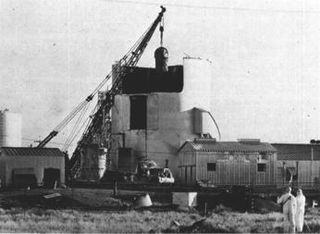
Stationary Low-Power Reactor Number One, also known as SL-1 or the Argonne Low Power Reactor (ALPR), was a United States Army experimental nuclear reactor in the western United States at the National Reactor Testing Station (NRTS) in Idaho about forty miles (65 km) west of Idaho Falls, now the Idaho National Laboratory. On January 3, 1961, at 9:01 pm MST, an operator fully pulled out the reactor’s central control rod, causing the reactor to go prompt critical. The intense heat generated an extreme water hammer which propelled the reactor vessel to the roof of the reactor building. The operator standing on top of the reactor lid was pinned to the roof of the reactor building with expelled control rod shield plugs, while the reactor expelled water, debris, and fuel. The release of materials hit two other operators, killing them. The reactor vessel then fell down to its original position. Press reported a steam explosion killed all three of its young military operators, pinning one of them to the ceiling with a reactor vessel plug. It remains the only U.S. reactor accident to cause immediate deaths.
NRX was a heavy-water-moderated, light-water-cooled, nuclear research reactor at the Canadian Chalk River Laboratories, which came into operation in 1947 at a design power rating of 10 MW (thermal), increasing to 42 MW by 1954. At the time of its construction, it was Canada's most expensive science facility and the world's most powerful nuclear research reactor. NRX was remarkable both in terms of its heat output and the number of free neutrons it generated. When a nuclear reactor such as NRX is operating, its nuclear chain reaction generates many free neutrons. In the late 1940s, NRX was the most intense neutron source in the world.
A dripstick is a thin hollow tube installed vertically in the bottoms of fuel tanks of many large aircraft, used to check fuel levels. To read a dripstick, it is withdrawn from the lower surface of the wing. When the top of the dripstick is withdrawn below the level of the fuel, fuel enters it and drips through a hole in the cap. Graduations on it indicate the level of fuel in the tank.
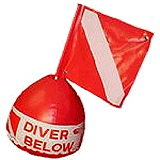
A surface marker buoy, SMB, dive float or simply a blob is a buoy used by scuba divers, at the end of a line from the diver, intended to indicate the diver's position to people at the surface while the diver is underwater. Two kinds are used; one (SMB) is towed for the whole dive, and indicates the position of the dive group throughout the dive, and the other, a delayed surface marker buoy, DSMB or decompression buoy, is deployed towards the end of the dive as a signal to the surface that the divers have started to ascend, and where they are going to surface. Both types can also function as a depth reference for controlling speed of ascent and accurately maintaining depth at decompression stops. Surface marker buoys are also used by freedivers in open water, to indicate the approximate position of the diver when submerged. They may also be used to support a catch bag or fish stringer by underwater hunters and collectors. A DSMB is considered by recreational scuba divers and service providers to be a highly important item of safety equipment, yet its use is not part of the entry level recreational diver training for all training agencies, and there are significant hazards associated with incompetent use.

A yoke, alternatively known as a control wheel or a control column, is a device used for piloting some fixed-wing aircraft.
Level sensors detect the level of liquids and other fluids and fluidized solids, including slurries, granular materials, and powders that exhibit an upper free surface. Substances that flow become essentially horizontal in their containers because of gravity whereas most bulk solids pile at an angle of repose to a peak. The substance to be measured can be inside a container or can be in its natural form. The level measurement can be either continuous or point values. Continuous level sensors measure level within a specified range and determine the exact amount of substance in a certain place, while point-level sensors only indicate whether the substance is above or below the sensing point. Generally the latter detect levels that are excessively high or low.
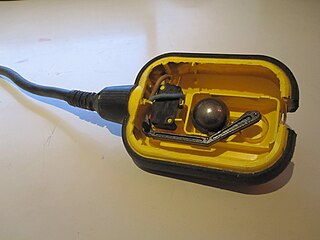
A float switch is a type of level sensor, a device used to detect the level of liquid within a tank. The switch may be used to control a pump, as an indicator, an alarm, or to control other devices.
In automotive and aerospace engineering, a fuel gauge is an instrument used to indicate the amount of fuel in a fuel tank. In electrical engineering, the term is used for ICs determining the current State of Charge of accumulators.
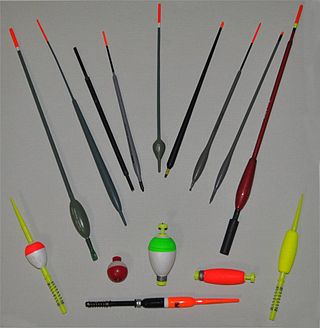
A fishing float or bobber is a lightweight buoy used in angling, usually attached to a fishing line. Angling using a float is sometimes called float fishing.

The Piper PA-11 Cub Special is a later-production variant of the J-3 Cub manufactured by Piper Aircraft.

The Canadian Vickers Vanessa was a Canadian biplane transport floatplane of the 1920s evaluated by the Royal Canadian Air Force (RCAF) and used briefly for delivering air-mail.

A hydraulic telegraph refers to two different semaphore systems involving the use of water-based mechanisms as a telegraph. The earliest one was developed in 4th-century BC Greece, while the other was developed in 19th-century AD Britain. The Greek system was deployed in combination with semaphoric fires, while the latter British system was operated purely by hydraulic fluid pressure.
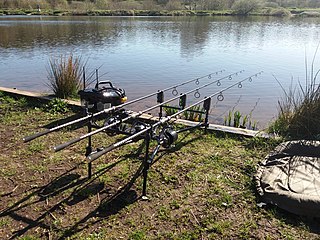
A bite indicator is any signalling device used in angling which alerts the fisherman of what is happening at the hook end of the fishing line, particularly whether a fish has swallowed the hook. It is the quintessential tackle used in bait fishing, which depends partly on luck and often requires unpredictable periods of time passively waiting for fish to bite the hook.
A pressure carburetor is a type of fuel metering system manufactured by the Bendix Corporation for piston aircraft engines, starting in the 1940s. It is recognized as an early type of throttle-body fuel injection and was developed to prevent fuel starvation during inverted flight.
An aircraft fuel system allows the crew to pump, manage, and deliver aviation fuel to the propulsion system and auxiliary power unit (APU) of an aircraft. Fuel systems differ greatly due to different performance of the aircraft in which they are installed. A single-engine piston aircraft has a simple fuel system; a tanker, in addition to managing its own fuel, can also provide fuel to other aircraft.
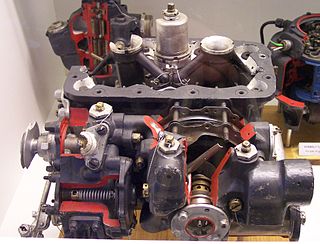
Of the three types of carburetors used on large, high-performance aircraft engines manufactured in the United States during World War II, the Bendix-Stromberg pressure carburetor was the one most commonly found. The other two carburetor types were manufactured by Chandler Groves and Chandler Evans Control Systems (CECO). Both of these types of carburetors had a relatively large number of internal parts, and in the case of the Holley Carburetor, there were complications in its "variable venturi" design.

The Bushcaddy R-80 is a Canadian ultralight and light-sport aircraft that was designed by Jean Eudes Potvin of Lac Saint-Jean, Quebec in 1994 and produced by his company Club Aeronautique Delisle Incorporated (CADI). It was later built by Canadian Light Aircraft Sales and Service (CLASS) of St. Lazare, Quebec and later Les Cedres, Quebec and now Bushcaddy of Lachute, Quebec.














